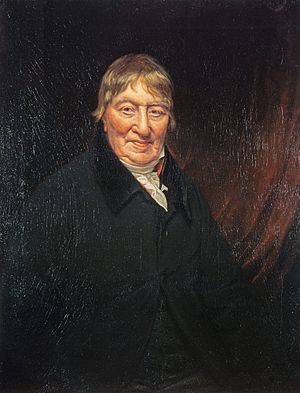George Chalmers (antiquarian) facts for kids
George Chalmers (born December 1742 – died May 31, 1825) was a Scottish historian and writer. He was very interested in old things and history, which is why he was called an "antiquarian." He also wrote a lot about politics.
Contents
About George Chalmers
George Chalmers was born in Fochabers, Moray, Scotland. He was the second son of James Chalmers, who was the local postmaster. After studying at King's College, Aberdeen, he went on to study law at the University of Edinburgh.
In 1763, George visited Maryland in British North America (which is now part of the United States). He started working as a lawyer in Baltimore. However, when the American War of Independence began, he supported the British side. People who supported the British during this war were called Loyalists. Because of his beliefs, he left his law practice and returned to Great Britain. It took him a few years to find a new job.
In 1786, George Chalmers got an important job as the chief clerk for a special government committee that dealt with trade. This committee was part of the Privy Council. He kept this job for the rest of his life, and it gave him time to write many books.
George was a member of several important groups, including the Royal Society and the Society of Antiquaries of London. These groups were for people who loved science and history. When he died, his large collection of books was passed to his nephew. Later, these books were sold.
His Writings and Debates
George Chalmers was a very strong writer, and he often got into arguments with other writers and historians. He disagreed with people like Edmond Malone, who edited Shakespeare's plays, and John Pinkerton, another historian.
Key Works
Caledonia: A History of Scotland
Chalmers' most important work was a book called Caledonia. He didn't finish it completely, but it's still a huge work about Scottish history.
The first part of Caledonia came out in 1807. It covered the history of Scotland from 80 AD to 1306 AD. It talked about the different groups of people who lived there, their languages, and the history of the government and churches. It also looked at how farming and trade developed in Scotland during those first 13 centuries. However, some parts about the Roman period were based on a fake document.
The second part, published in 1810, described seven southeastern counties of Scotland. These included places like Roxburgh, Berwick, and Edinburgh. For each county, he wrote about its name, location, natural features, old buildings, history, farming, factories, trade, and church history.
In 1824, the third part was released. This one described seven southwestern counties, such as Dumfries, Ayr, and Lanark. George Chalmers had also gathered information for the central and northern parts of Scotland, but he passed away before he could finish them.
Other Important Books
Before his government job, Chalmers wrote about the history of the English colonies in North America. He had access to many important government papers. His book, Political Annals of the present United Colonies from their Settlement to the Peace of 1763 (1780), explained how the different American colonies were first settled and how their governments changed.
He also wrote An Estimate of the Comparative Strength of Britain during the Present and Four Preceding Reigns (1782), which was a popular book about Britain's power.
Biographies and Other Topics
George Chalmers wrote life stories (biographies) for several famous people, including the writer Daniel Defoe and the poet Allan Ramsay. He also wrote a biography of Thomas Paine, a famous American writer, but he used a fake name for that one.
In 1818, he published a life story of Mary, Queen of Scots. He spent a lot of time studying Mary's history. His last work was about some letters that were supposedly written by Mary, Queen of Scots, but Chalmers showed they were fake.
Chalmers also wrote about other interesting topics. He wrote about the Ireland Shakespeare forgeries, which were fake Shakespeare documents. He also tried to figure out who the mysterious writer "Junius" was, who wrote famous letters in the 1700s.
His political writings included:
- Collection of Treaties between Great Britain and other Powers (1790)
- A Chronological Account of Commerce and Coinage in Great Britain from the Restoration till 1850 (1810)
- Opinions of Eminent Lawyers on various points of English Jurisprudence, chiefly concerning the Colonies, Fisheries, and Commerce of Great Britain (1814)
Chalmers' works online
- Political annals of the present United Colonies: ... (1779)
- An Estimate of the Comparative Strength of Britain during the Present and Four Preceding Reigns (1782)
- The Life of Thomas Ruddiman (1794)
- An Apology for the Believers in the Shakespeare Papers which were exhibited in Norfolk Street (1797)
- The Life of Mary, Queen of Scots, Derived from State Papers Volume 1 Volume 2 (1818)
- A supplemental apology for the believers in the Shakspear papers (1799)
- Caledonia (1888-1894 republication): Vols 3-7 (NLS), corresponding to the original books 2 and 3.


